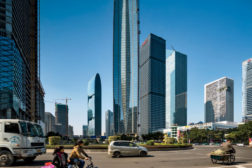Articles by Joann Gonchar, FAIA
Pearl River Tower
Towering Ambition: The architects and engineers behind an office building in rapidly expanding Guangzhou put super green before supertall.
Read More
Thurgood Marshall U.S. Courthouse
Order in the Court: A multidisciplinary design team applies a light and skillful touch to restore luster to a faded Lower Manhattan landmark while bringing it up to current standards.
Read More
Modular Classroom Makeover
New designs for portable school buildings make improvements that are more than cosmetic.
Read More
Marc Fornes/TheVeryMany
A small studio deploys computational design and digital fabrication to make inventive structures that define space.
Read More
Krishna P. Singh Center for Nanotechnology
The Art of Science: A new center for the study of nanotechnology merges landscape with building, and sculpture with architecture, reshaping a formerly bleak part of the University of Pennsylvania campus.
Read More
Facade Retrofits: Wrap It Up
Face-lifts for three buildings showing their age aim to correct performance problems, project a more desirable image, and address the needs of new occupants.
Read More
Shady Business
Integrated designs for lighting and daylighting, automated by controls, can help conserve resources and please building occupants.
Read More
Energy Biosciences Building
Sophisticated controls help keep energy use in check while supporting critical research focused on climate change.
Read More
Copyright ©2024. All Rights Reserved BNP Media.
Design, CMS, Hosting & Web Development :: ePublishing

